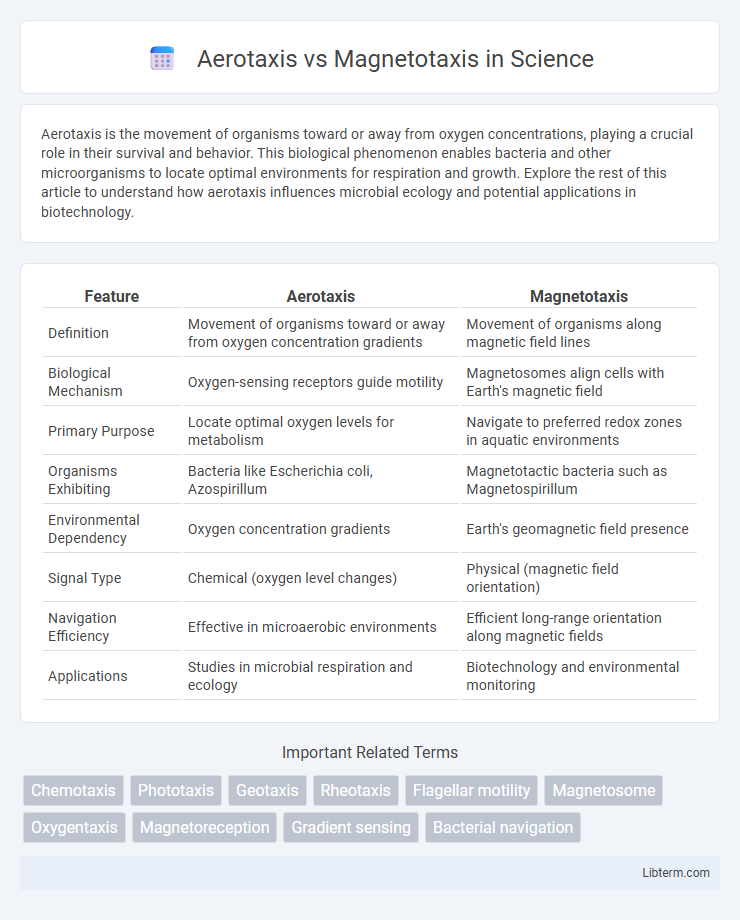Aerotaxis is the movement of organisms toward or away from oxygen concentrations, playing a crucial role in their survival and behavior. This biological phenomenon enables bacteria and other microorganisms to locate optimal environments for respiration and growth. Explore the rest of this article to understand how aerotaxis influences microbial ecology and potential applications in biotechnology.
Table of Comparison
| Feature | Aerotaxis | Magnetotaxis |
|---|---|---|
| Definition | Movement of organisms toward or away from oxygen concentration gradients | Movement of organisms along magnetic field lines |
| Biological Mechanism | Oxygen-sensing receptors guide motility | Magnetosomes align cells with Earth's magnetic field |
| Primary Purpose | Locate optimal oxygen levels for metabolism | Navigate to preferred redox zones in aquatic environments |
| Organisms Exhibiting | Bacteria like Escherichia coli, Azospirillum | Magnetotactic bacteria such as Magnetospirillum |
| Environmental Dependency | Oxygen concentration gradients | Earth's geomagnetic field presence |
| Signal Type | Chemical (oxygen level changes) | Physical (magnetic field orientation) |
| Navigation Efficiency | Effective in microaerobic environments | Efficient long-range orientation along magnetic fields |
| Applications | Studies in microbial respiration and ecology | Biotechnology and environmental monitoring |
Introduction to Aerotaxis and Magnetotaxis
Aerotaxis refers to the directed movement of microorganisms toward or away from oxygen gradients, enabling cells to find optimal oxygen concentrations for metabolism. Magnetotaxis involves the navigation of bacteria using Earth's magnetic field through magnetosomes, aligning cellular movement along geomagnetic field lines. Both mechanisms serve as adaptive strategies to enhance survival in varying environmental conditions by guiding motility based on specific external cues.
Defining Aerotaxis: Mechanisms of Response
Aerotaxis refers to the directed movement of microorganisms towards or away from oxygen gradients, primarily mediated by specialized sensory proteins such as heme-containing aerotactic receptors that detect changes in oxygen concentration. The underlying mechanism involves signal transduction pathways that modulate flagellar rotation or motility patterns, enabling cells to optimize their positioning within oxygen-rich or oxygen-poor environments. This adaptive response contrasts with magnetotaxis, which relies on intracellular magnetosomes to align movement along geomagnetic fields rather than chemical gradients.
Understanding Magnetotaxis: Navigating Magnetic Fields
Magnetotaxis refers to the ability of certain microorganisms to orient and navigate along magnetic fields, using magnetosomes--intracellular magnetic nanoparticles--as biological compasses. These magnetotactic bacteria align themselves with Earth's geomagnetic field to efficiently locate optimal oxygen concentrations or redox conditions in aquatic environments. Understanding magnetotaxis involves studying the genetic and biochemical mechanisms behind magnetosome formation and the sensory pathways that convert magnetic cues into directed motility.
Evolutionary Significance of Tactic Behaviors
Aerotaxis and magnetotaxis demonstrate evolutionary adaptations enabling microorganisms to navigate their environments efficiently by sensing oxygen concentration and magnetic fields, respectively. Aerotaxis evolved to optimize energy production by guiding bacteria toward optimal oxygen levels, enhancing metabolic efficiency and survival. Magnetotaxis allows microbes to align with Earth's magnetic field, facilitating navigation to favorable microaerophilic zones and contributing to ecological niche specialization and evolutionary fitness.
Molecular Pathways of Aerotaxis
Aerotaxis in bacteria involves molecular pathways primarily centered on the direct sensing of oxygen gradients through specialized oxygen-binding proteins such as HemAT, a heme-containing aerotactic receptor. Signal transduction from HemAT typically activates a two-component system involving sensor kinases and response regulators, modulating flagellar rotation to guide movement toward optimal oxygen concentrations. This process contrasts with magnetotaxis, which relies on magnetosome chains and magnetic field detection rather than chemical oxygen sensing, highlighting distinct molecular mechanisms underlying bacterial navigation strategies.
Cellular Mechanisms Underlying Magnetotaxis
Magnetotaxis is driven by specialized magnetosome chains within magnetotactic bacteria, where intracellular magnetite or greigite crystals align the cells along geomagnetic fields, enabling directional movement. These magnetic organelles interact with flagellar motors through signaling proteins, allowing cells to sense and navigate magnetic gradients. In contrast, aerotaxis relies on gas-sensing receptor proteins that modulate flagellar rotation in response to oxygen concentration changes but lack magnetic field sensitivity.
Environmental Influences on Tactic Movements
Aerotaxis is influenced by oxygen concentration gradients, with bacteria moving toward optimal oxygen levels essential for their metabolic processes. Magnetotaxis relies on Earth's magnetic field lines, guiding magnetotactic bacteria to preferred redox zones in aquatic sediments for favorable environmental conditions. Variations in oxygen availability and geomagnetic field intensity critically affect the efficiency and directionality of these tactic movements.
Comparative Advantages: Aerotaxis vs Magnetotaxis
Aerotaxis enables microorganisms to efficiently locate optimal oxygen concentrations, enhancing metabolic activity in dynamic environments, while magnetotaxis allows navigation along geomagnetic fields, providing spatial orientation in sediment or aquatic habitats. Aerotactic responses are rapid and adaptable to fluctuating oxygen gradients, whereas magnetotactic behavior offers energy-efficient, directional movement over longer distances with less environmental variability impact. Comparative advantages include aerotaxis excelling in environments with variable oxygen availability, and magnetotaxis proving beneficial in stable magnetic field conditions for sustained migration or positioning.
Applications in Biotechnology and Environmental Science
Aerotaxis enables bacteria to navigate oxygen gradients, making it valuable for bioremediation processes that target oxygen-sensitive pollutants and in biosensor development for monitoring environmental oxygen levels. Magnetotaxis harnesses magnetotactic bacteria's ability to align with magnetic fields, facilitating targeted drug delivery and enhanced pollutant degradation in contaminated water via magnetic guidance. Both mechanisms improve microbial efficiency in environmental cleanup and biotechnological innovations, leveraging natural sensory responses to optimize treatment and monitoring strategies.
Future Directions in Tactic Behavior Research
Future directions in tactic behavior research emphasize integrating aerotaxis and magnetotaxis studies to develop biohybrid systems for precise environmental sensing and navigation. Emerging technologies in genetic engineering and microfluidics enable manipulation of bacterial responses to oxygen and magnetic fields, enhancing control over microbial movement. Advancements in computational modeling facilitate the simulation of complex tactic behaviors, driving innovations in targeted drug delivery and ecological monitoring.
Aerotaxis Infographic

 libterm.com
libterm.com